A Comprehensive Methodology for Evaluating the Economic Impacts of Floods: An Application to Canada, Mexico, and the United States
Abstract
:1. Introduction
2. Methodology
2.1. A Brief Recap of the Methodology Development
2.2. Data Collection and Analysis
2.2.1. Data Collection
3. Results
3.1. Summary of Flood Events across Canada, Mexico, and the United States from 2013 to 2017
3.2. Data Availability for Flood Events across Canada, Mexico, and the United States from 2013 to 2017
3.3. Case Study Analysis
3.3.1. The 2016 Fort McMurray Wildfire and Flooding, Province of Alberta, Canada
3.3.2. The 2013 La Montaña Region Landslide and Flooding, State of Guerrero, Mexico
3.3.3. The 2016 Louisiana and Texas Flooding, the United States
4. Discussion
4.1. National Flood Cost Data Accessibility and Availability
4.2. Sectoral Flood Cost Data Accessibility and Availability
4.3. Research Opportunities, Limitations, and Recommendations
5. Conclusions
Supplementary Materials
Author Contributions
Funding
Institutional Review Board Statement
Informed Consent Statement
Data Availability Statement
Acknowledgments
Conflicts of Interest
References
- Adeel, Z.; Alarcón, A.M.; Bakkensen, L.; Franco, E.; Garfin, G.M.; McPherson, R.A.; Méndez, K.; Roudaut, M.B.; Saffari, H.; Wen, X. Developing a comprehensive methodology for evaluating economic impacts of floods in Canada, Mexico and the United States. Int. J. Disaster Risk Reduct. 2020, 50, 101861. [Google Scholar] [CrossRef]
- Rojas, R.; Feyen, L.; Watkiss, P. Climate change and river floods in the European Union: Socio-economic consequences and the costs and benefits of adaptation. Global Environ. Change 2013, 23, 1737–1751. [Google Scholar] [CrossRef]
- Ward, P.J.; Jongman, B.; Aerts, J.C.J.H.; Bates, P.D.; Botzen, W.J.W.; Loaiza, A.D.; Hallegatte, S.; Kind, J.M.; Kwadijk, J.; Scussolini, P.; et al. A global framework for future costs and benefits of river-flood protection in urban areas. Nat. Clim. Change 2017, 7, 642–646. [Google Scholar] [CrossRef] [Green Version]
- Bakkensen, L.A.; Blair, L. Flood Damage Assessments: Theory and evidence from the United States. In Oxford Research Encyclopedia of Politics; Oxford University Press: Oxford, UK, 2020. [Google Scholar]
- Hirabayashi, Y.; Mahendran, R.; Koirala, S.; Konoshima, L.; Yamazaki, D.; Watanabe, S.; Kim, H.; Kanae, S. Global flood risk under climate change. Nat. Clim Change 2013, 3, 816–821. [Google Scholar] [CrossRef]
- van der Wiel, K.; Kapnick, S.B.; Van Oldenborgh, G.J.; Whan, K.; Philip, S.; Vecchi, G.A.; Singh, R.K.; Arrighi, J.; Cullen, H. Rapid attribution of the August 2016 flood-inducing extreme precipitation in south Louisiana to climate change. Hydrol. Earth Syst. Sci. 2017, 21, 897–921. [Google Scholar] [CrossRef] [Green Version]
- Hodgkins, G.A.; Whitfield, P.H.; Burn, D.H.; Hannaford, J.; Renard, B.; Stahl, K.; Fleig, A.K.; Madsen, H.; Mediero, L.; Korhonen, J.; et al. Climate-driven variability in the occurrence of major floods across North America and Europe. J. Hydrol. 2017, 552, 704–717. [Google Scholar] [CrossRef] [Green Version]
- Bertrand, D.; McPherson, R.A. Future Hydrologic Extremes of the Red River Basin. J. Appl. Meteorol. Climatol. 2018, 57, 1321–1336. [Google Scholar] [CrossRef]
- UNISDR (United Nations International Strategy for Disaster Reduction). Sendai Framework for Disaster Risk Reduction 2015–2030. 2015. Available online: https://www.preventionweb.net/files/43291_sendaiframeworkfordrren.pdf (accessed on 10 August 2022).
- International Institute for Sustainable Development, 2022. Summary Report GP2022. Available online: https://globalplatform.undrr.org/news/23-28-may-2022-summary-report-gp2022 (accessed on 10 August 2022).
- Oulahen, G. Flood Insurance in Canada: Implications for Flood Management and Residential Vulnerability to Flood Hazards. Environ. Manag. 2014, 55, 603–615. [Google Scholar] [CrossRef]
- Haer, T.; Botzen, W.J.W.; Van Roomen, V.; Connor, H.; Zavala-Hidalgo, J.; Eilander, D.; Ward, P.J. Coastal and river flood risk analyses for guiding economically optimal flood adaptation policies: A country-scale study for Mexico. Phil. Trans. R. Soc. A 2018, 376, 20170329. [Google Scholar] [CrossRef]
- Davenport, F.V.; Burke, M.; Diffenbaugh, N.S. Contribution of historical precipitation change to us flood damages. Proc. Natl. Acad. Sci. USA 2021, 118, e2017524118. [Google Scholar] [CrossRef]
- Garfin, G.; Jardine, A.; Merideth, R.; Black, M.; LeRoy, S. Assessment of Climate Change in the Southwest United States: A Report Prepared for the National Climate Assessment; Island Press: Washington, DC, USA, 2013. [Google Scholar]
- Thistlethwaite, J.; Henstra, D. Municipal flood risk sharing in Canada: A policy instrument analysis. Can. Water Resour. J. Rev. Can. Des Ressour. Hydr. 2017, 42, 349–363. [Google Scholar] [CrossRef]
- Bergsma, E. The development of flood risk management in the United States. Environ. Sci. Policy 2019, 101, 32–37. [Google Scholar] [CrossRef]
- Bakkensen, L.A.; Ma, L. Sorting over flood risk and implications for policy reform. J. Environ. Econ. Manag. 2020, 104, 102362. [Google Scholar] [CrossRef]
- UN-ECLAC, 2003, 2014. Handbook for Disaster Assessment. Economic Commission for Latin America and the Caribbean. LC/L.3691, 2013-817. Copyright © United Nations, April 2014. Available online: https://repositorio.cepal.org/bitstream/handle/11362/36823/S2013817_en.pdf?sequence=1&isAllowed=y) (accessed on 14 October 2022).
- Bitrán, D. Evaluación Retrospectiva del Impacto Socioeconómico de los Desastres y Consideraciones Metodológicas; Mayo Clinic: Rochester, MN, USA, 2005. [Google Scholar]
- Toscana, A.; Villaseñor, A. Las Tormentas Ingrid y Manuel en La Montaña de Guerrero. In La Atención de la emergencia; Sociedad y Ambiente, año 6, núm. 16, marzo-junio de 2018; Sociedad y Ambiente: Mexico city, Mexico, 2013; pp. 59–89. ISSN 2007-6576. [Google Scholar]
- CENAPRED. Impacto Socioeconómico de los Principales Desastres Ocurridos en la República Mexicana en 2013; Versión Electrónica 2015; SEGOB: Mexico city, Mexico, 2013.
- CENAPRED. Impacto Socioeconómico de los Principales Desastres Ocurridos en la República Mexicana en 2014; Versión Electrónica 2016; SEGOB: Mexico city, Mexico, 2014.
- CENAPRED. Impacto Socioeconómico de los Principales Desastres Ocurridos en la República Mexicana en 2016; Versión Electrónica 2018; SEGOB: Mexico city, Mexico, 2016.
- CENAPRED. Impacto Socioeconómico de los Principales Desastres Ocurridos en la República Mexicana en 2017; Versión Electrónica 2019; SEGOB: Mexico city, Mexico, 2017.
- NOAA National Centers for Environmental Information (NCEI) U.S. Billion-Dollar Weather & Climate Disasters 1980–2020. 2020. Available online: https://www.ncdc.noaa.gov/billions/ (accessed on 1 October 2020).
- Alam, R.; Islam, S.; Mosely, E.; Thomas, S.; Dodwell, V.; Doel, D. Rapid Impact Assessment of the Fort McMurray Wildfire; MacEwan University: Edmonton, AB, Canada, 2017. [Google Scholar]
- CatIQ. Catastrophe Loss Database. 2020. Available online: https://public.catiq.com/products/ (accessed on 17 December 2020).
- Louisiana Office of Community Development, Disaster Recovery Unit. 2021. 2016 Floods CDBG Program Allocations, Obligations, and Expenditures for October–December 2020 Appropriations. Report Date: 4 January 2021. Available online: https://www.doa.la.gov/media/3eqj00px/flood_expenditures_4thq2020.pdf (accessed on 10 January 2021).
- American Red Cross. Louisiana Flooding Six-Month Update-March 2017. 2017. Available online: https://www.redcross.org/content/dam/redcross/imported-pdfs/Louisiana_Floods_Stewardship_6-Month_Update.pdf (accessed on 10 January 2021).
- United States Department of Housing and Urban Development. HUD Awards $500 Million to Help Louisiana, Texas & West Virginia to Recover From Historic Flooding: Funding to Address Counties with Most Critical Needs. HUD Archives: News Releases. For Release, Thursday, 13 October 2016. Available online: https://archives.hud.gov/news/2016/pr16-156.cfm (accessed on 10 January 2021).
- Smith, A.; National Oceanic and Atmospheric Administration. Personal Communication, 2020.
- Arosio, M.; Arrighi, C.; Cesarini, L.; Martina, M.L.V. Service Accessibility Risk (SAR) Assessment for Pluvial and Fluvial Floods in an Urban Context. Hydrology 2021, 8, 142. [Google Scholar] [CrossRef]
- Carrera, L.; Standardi, G.; Bosello, F.; Mysiak, J. Assessing direct and indirect economic impacts of a flood event through the integration of spatial and computable general equilibrium modelling. Environ. Modell. Softw. 2015, 63, 109–122. [Google Scholar] [CrossRef] [Green Version]
- Mendoza-Tinoco, D.; Guan, D.; Zeng, Z.; Xia, Y.; Serrano, A. Flood footprint of the 2007 floods in the UK: The case of the Yorkshire and The Humber region. J. Clean. Prod. 2017, 168, 655–667. [Google Scholar] [CrossRef] [Green Version]
- Zhong, S.; Yang, L.; Toloo, S.; Wang, Z.; Tong, S.; Sun, X.; Crompton, D.; FitzGerald, G.; Huang, C. The long-term physical and psychological health impacts of flooding: A systematic mapping. Sci. Total Environ. 2018, 626, 165–194. [Google Scholar] [CrossRef]
- Walters, K.M.; Babbar-Sebens, M. Using climate change scenarios to evaluate future effectiveness of potential wetlands in mitigating high flows in a Midwestern, U.S. watershed. Ecol. Eng. 2016, 89, 80–102. [Google Scholar] [CrossRef] [Green Version]
- Byakatonda, J.; Parida, B.P.; Kenabatho, P.K. Relating the dynamics of climatological and hydrological droughts in semiarid Botswana. Phys. Chem. Earth 2018, 105, 12–24. [Google Scholar] [CrossRef]
- Greenhoot, A.F.; Dowsett, C.J. Secondary Data Analysis: An Important Tool for Addressing Developmental Questions. J. Cogn. Dev. 2012, 13, 2–18. [Google Scholar] [CrossRef]
- Gall, M.; Borden, K.A.; Cutter, S.L. When do losses count? Six fallacies of natural hazards loss data. Bull. Am. Meteorol. Soc. 2009, 90, 799–809. [Google Scholar] [CrossRef]
- CTV News. Timeline: ‘The Beast’ Hits Fort McMurray, and the Recovery. 2018. Available online: https://edmonton.ctvnews.ca/timeline-the-beast-hits-fort-mcmurray-and-the-recovery-1.3914168 (accessed on 6 September 2022).
- KPMG. May 2016 Wood Buffalo Wildfire Post-Incident Assessment Report: Prepared for Alberta Emergency Management Agency; KPMG: Amstelveen, The Netherlands, 2017. [Google Scholar]
- Clark, T.D. Rebuilding Resilient Indigenous Communities in the RMWB. Final Report. 2018. Available online: https://static1.squarespace.com/static/615cce89f72da40d46b95fc6/t/6192c14208d95a1ec5b53bba/1637007685737/Rebuilding-Resilient-Indigenous-Communities-Final-Report-Final-1.pdf (accessed on 6 September 2022).
- CTV News. Fire-Ravaged Fort McMurray Now Facing Flooding. 2016. Available online: https://www.ctvnews.ca/canada/fire-ravaged-fort-mcmurray-now-facing-flooding-1.3009894 (accessed on 6 September 2022).
- Public Safety Canada. Canadian Disaster Database. 2020. Available online: https://www.publicsafety.gc.ca/cnt/rsrcs/cndn-dsstr-dtbs/index-en.aspx (accessed on 6 September 2022).
- Comisión Nacional del Agua (CONAGUA), Servicio Meteorológico Nacional, Reporte Anual, 2013. Reporte del Clima en México. Available online: http://smn.cna.gob.mx/climatologia/analisis/reporte/Anual2013.pdf (accessed on 6 September 2022).
- Lightbody, L. The Most Costly U.S. Floods of 2016. The Pew Charitable Trusts. 30 January 2017. Available online: https://www.pewtrusts.org/en/research-and-analysis/articles/2017/01/30/the-most-costly-us-floods-of-2016 (accessed on 6 September 2022).
- National Weather Service. Heavy Rain and Flooding. 8–11 March 2016. Available online: https://www.weather.gov/shv/event_2016-03-09_flooding (accessed on 6 September 2022).
- United States Geological Survey. Southern Spring Floods. 2016. Available online: https://www.usgs.gov/mission-areas/water-resources/science/2016-southern-spring-floods?qt-science_center_objects=0#qt-science_center_objects (accessed on 6 September 2022).
- Jerolleman, A. Challenges of Post-Disaster Recovery in Rural Areas. In Louisiana’s Response to Extreme Weather; Springer: Cham, Germany, 2020; pp. 285–310. [Google Scholar]
- United South and Eastern Tribes. 2016 Annual Report. USET Sovereignty Protection Fund (USET SFP). 2016. Available online: https://www.usetinc.org/resources/annual-reports/ (accessed on 6 September 2022).
- National Oceanic and Atmospheric Administration. Climate Change Increased Chances of Record Rains in Louisiana by at Least 40 Percent. NOAA and Partners Conduct Rapid Assessment of Devastating August Rains. 2016. Available online: https://www.noaa.gov/media-release/climate-change-increased-chances-of-record-rains-in-louisiana-by-at-least-40-percent (accessed on 6 September 2022).
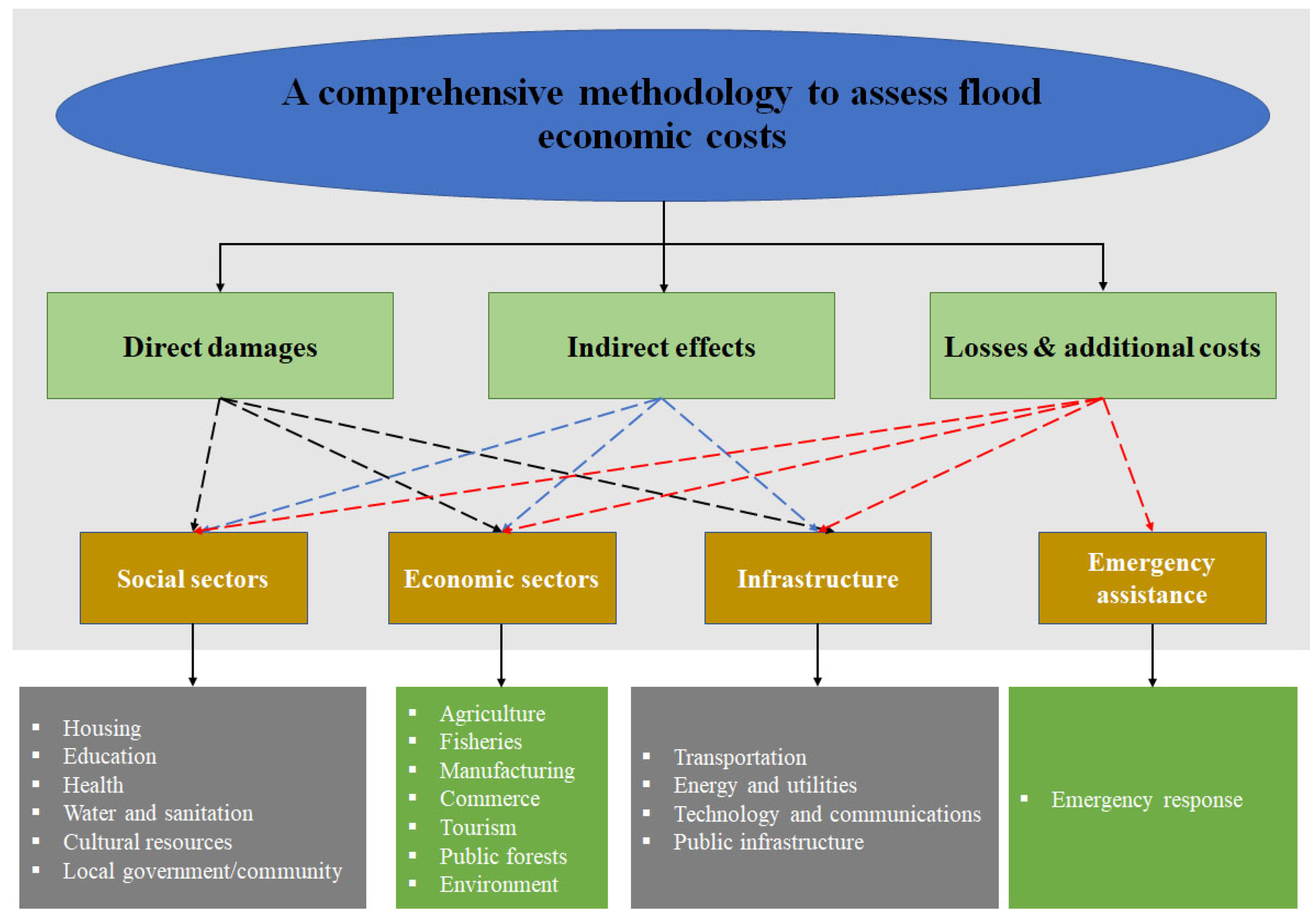


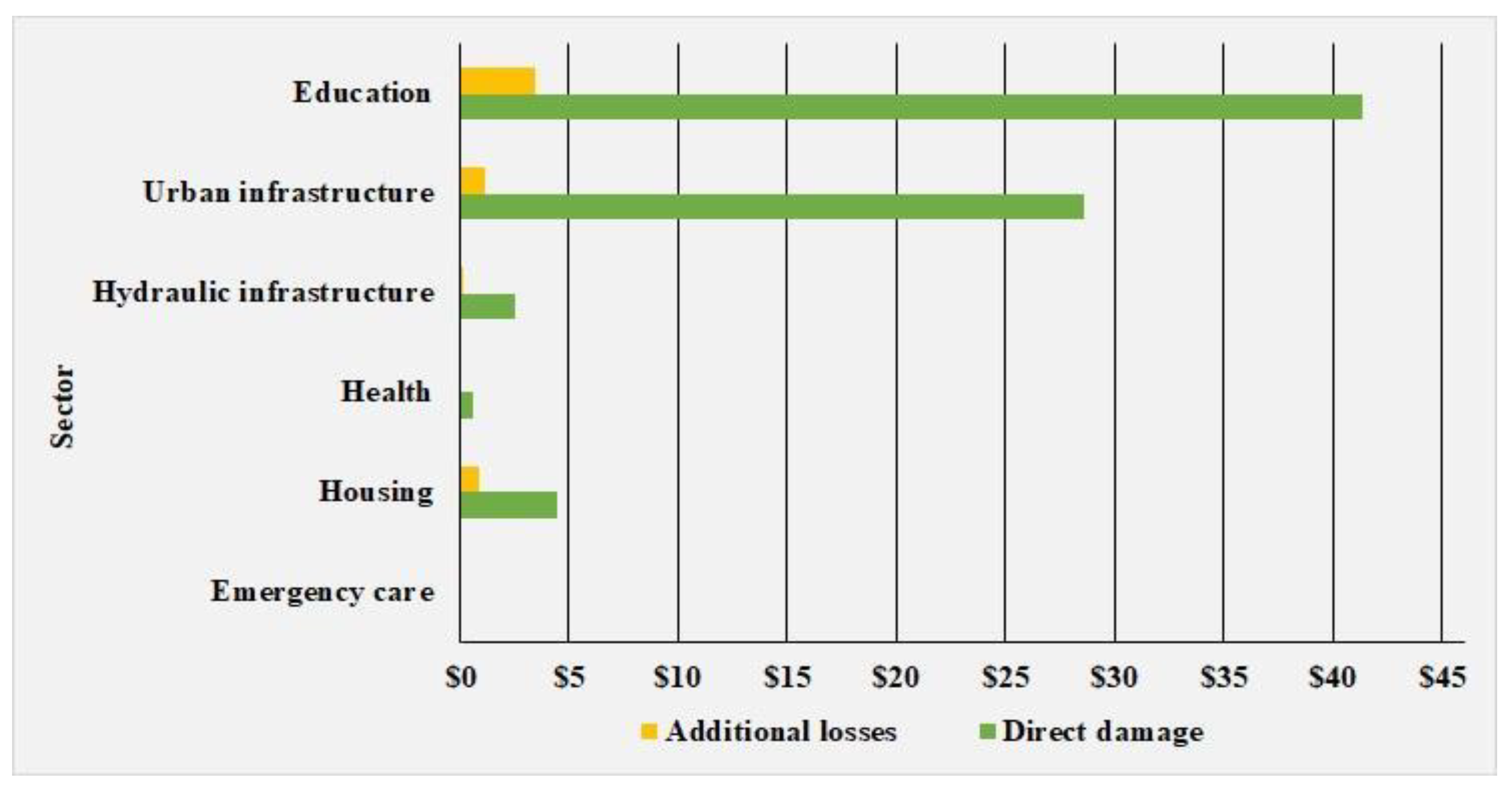
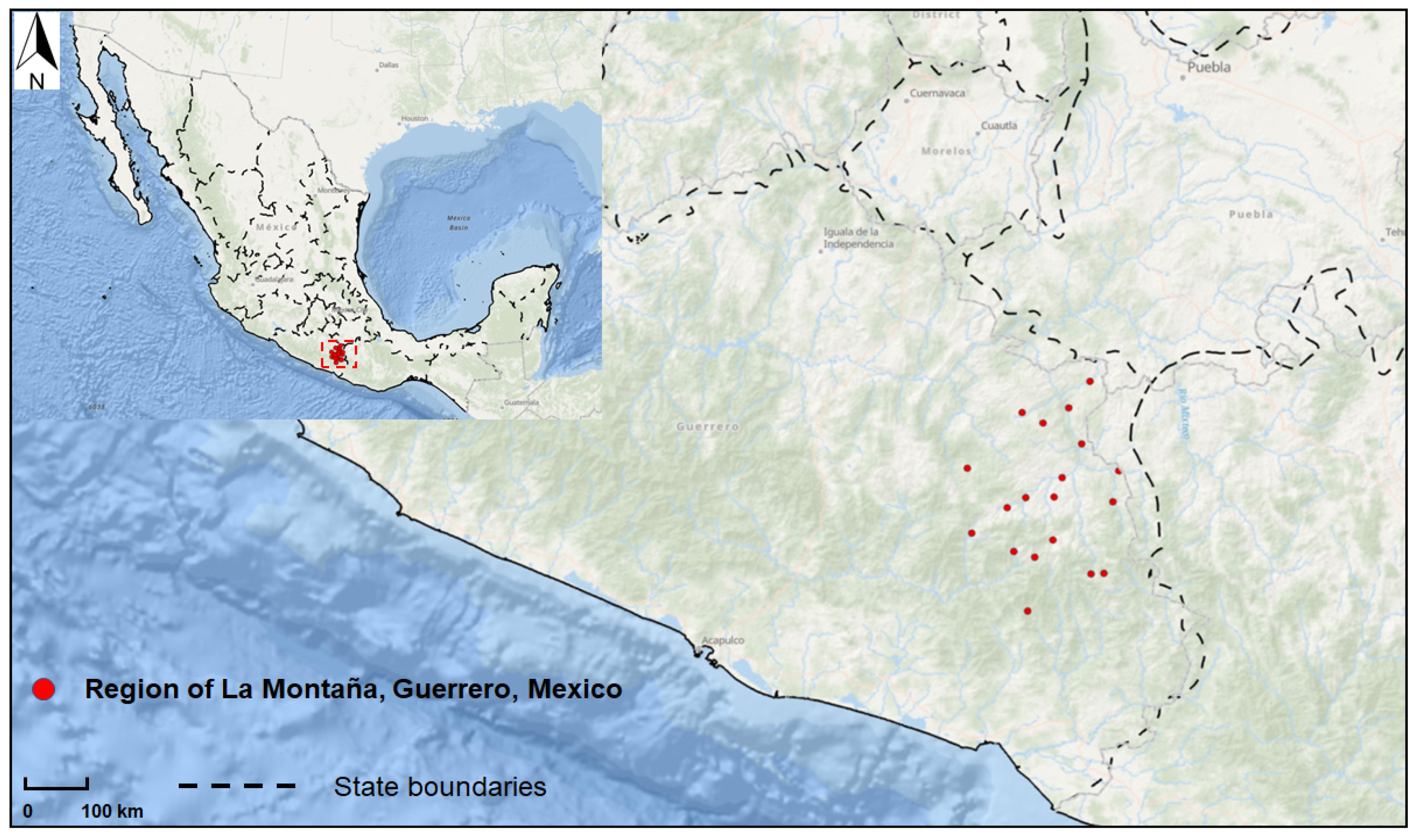
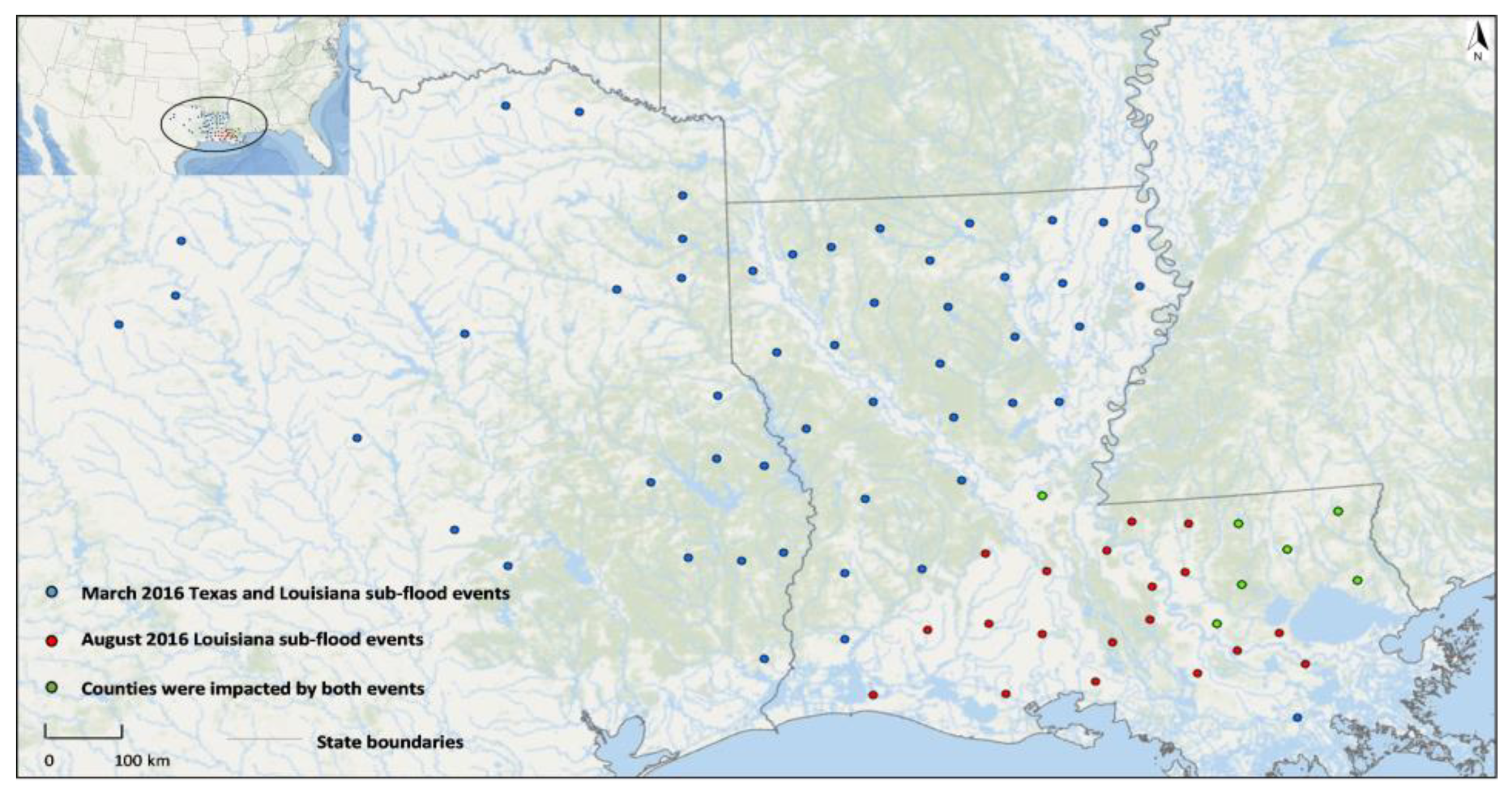
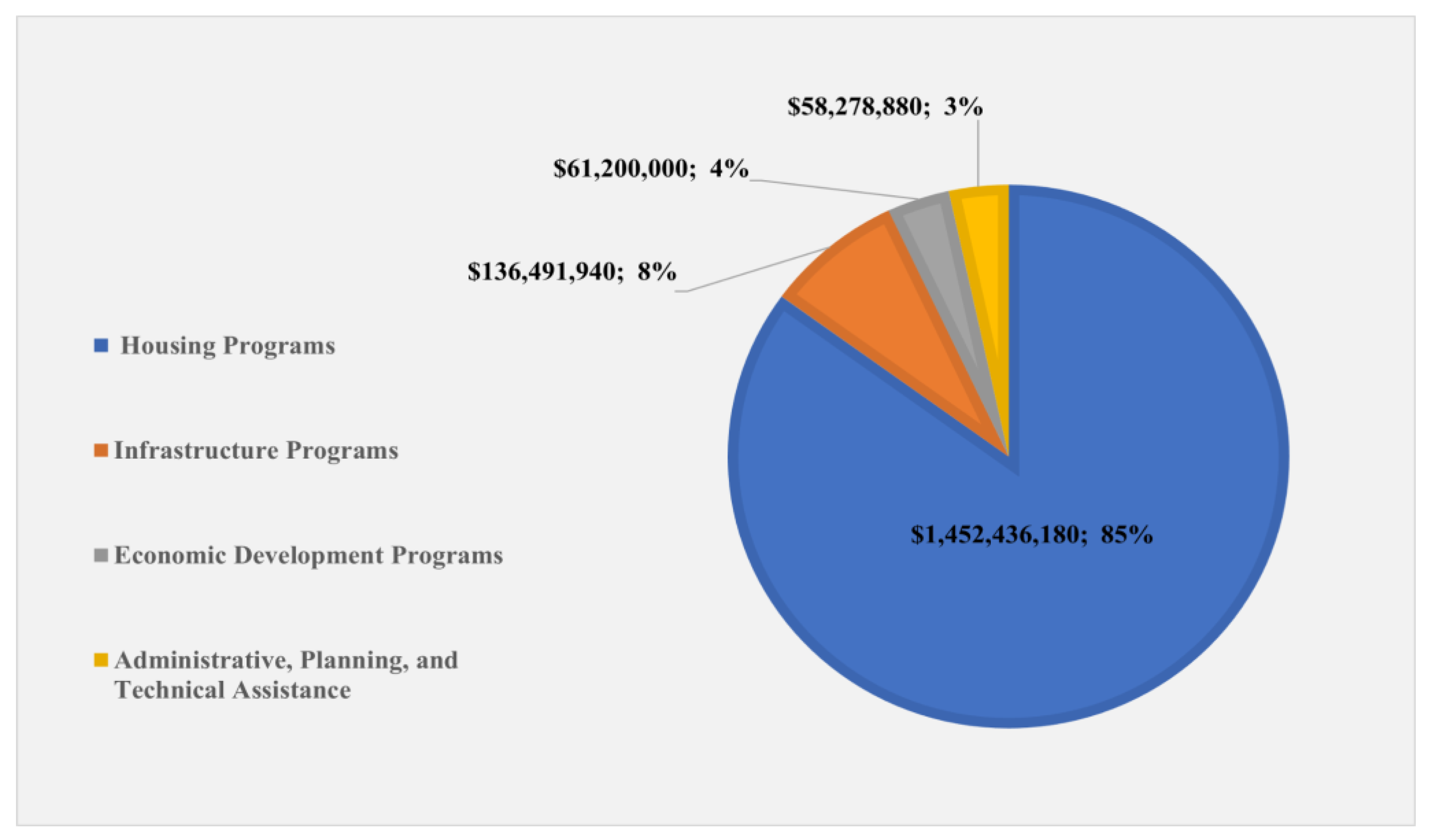

| Major Flood Events (2013–2017) | |
| Required | It caused significant economic damages (e.g., cited as “most costly disaster) and significantly affected population or areas (e.g., affected by multiple municipalities or ≥1000 people affected). |
| Preferred | The government declared a national or provincial appeal (e.g., a declaration of a state of emergency). |
| Case Study Flood Events (2013–2017) | |
| Required | Prior reports and publications were available that allow the research team working on each case study to determine the inter-linkages between various events. Moreover, the economic impacts for the event(s) were well recorded and accessible. |
| Preferred | Each selected case-study event affected at least one Indigenous community or in both urban and rural communities or crossed state/province borders. |
| Major Flood-Event Analysis | |
| County | Data source |
| Canada | Catastrophe Indices and Quantification Inc. (2013–2017) |
| Mexico | CENAPRED Book Series «Impacto Socioeconómico de los principales Desastres ocurridos en la República Mexicana» (2013–2017) |
| The United States | FEMA Disaster Declarations (2013–2017) |
| FEMA National Flood Insurance Program (2013–2017) | |
| FEMA Individual Assistance Program (Homeowners and Renters Assistance) (2013–2017) | |
| FEMA Public Assistance (2013–2017) | |
| National Oceanic and Atmospheric Administration Storm Events (2013–2017) | |
| U.S. Small Business Administration Disaster Assistance (Home and Business Loans) (2013–2017) | |
| United States Department of Agriculture Risk Management Agency (2013–2017) | |
| Additional Data Sources Case Study Analysis | |
| Canada | Wildfire: The Rapid Impact Assessment of Fort McMurray Wildfire (2017) |
| Mexico | Toscana and Villaseñor [20] |
| The United States (See Section 3.3.3 for a discussion of how federal datasets are additionally used in the U.S. case study) | U.S. Housing and Urban Development: Community Development Block Grant Program disaster fund allocations. Louisiana Office of Community Development, Disaster Recovery Unit (2021) |
| Private Insurance Marketplace damage and loss data (A. Smith, personal communication, 23 December 2020) | |
| American Red Cross: costs for disaster services and supplies (2017) | |
| Auxiliary Data | |
| Canada (Census data are utilized to change the geographic scale of the Canadian data (see supplementary materials Table S2)) | The 2016 Census Program, Statistics Canada |
| Event No. | Date | Flood Events | Country | Flood Event Brief Description | Total Costs of Flood Events |
|---|---|---|---|---|---|
| 1 | May 2013 | Chiapas flooding | Mexico | Hurricane Barbara | USD 0.14 |
| 2 | June 2013 | Southern Alberta flooding | Canada | Persistent rain due to stationary system | USD 1.68 |
| 3 | July 2013 | Toronto flooding | Canada | Thunderstorm/flash flooding | USD 0.93 |
| 4 | September 2013 | Colorado flooding | United States | Flash flooding/debris flow | USD 0.67 |
| 5 | September 2013 | Guerrero flooding | Mexico | Hurricane Manuel | USD 2.87 |
| 6 | September 2013 | Nuevo León flooding | Mexico | Hurricane Ingrid | USD 0.21 |
| 7 | June 2014 | Southern Saskatchewan and Manitoba flooding | Canada | Persistent rain due to stationary system | USD 0.12 |
| 8 | August 2014 | Michigan and Northeast flooding | United States | Flash flooding/heavy rain | USD 0. 19 |
| 9 | September 2014 | Baja California Sur flooding | Mexico | Hurricane Odile | USD 1.82 |
| 10 | October 2015 | South Carolina and east coast flooding | United States | Flash flooding/heavy rain | USD 0.52 |
| 11 | March 2016 | Texas and Louisiana flooding | United States | Flash flooding/heavy rain | USD 0.66 |
| 12 | April 2016 | Houston flooding | United States | Flash flooding/heavy rain | USD 0.67 |
| 13 | June 2016 | Prairies and Northern Ontario flooding | Canada | Heavy rain | USD 0.03 |
| 14 | July 2016 | Prairie long weekend severe storms | Canada | Heavy rain | USD 0.37 |
| 15 | August 2016 | Louisiana flooding | United States | Flash flooding/heavy rain | USD 5.18 |
| 16 | August 2016 | Puebla flooding | Mexico | Tropical storm Earl | USD 0.19 |
| 17 | September 2016 | Windsor and Tecumseh Ontario flooding | Canada | Persistent rain due to stationary system | USD 0.13 |
| 18 | October 2016 | Nova Scotia, Prince Edward Island, and Newfoundland flooding | Canada | Hurricane Matthew | USD 0.08 |
| 19 | February 2017 | California flooding | United States | Severe winter storms, flooding, mudslides, and potential failure of the Emergency Spillway at Oroville Lake | USD 0.21 |
| 20 | May 2017 | Ontario and Quebec Spring flooding | Canada | Melting snow and ice | USD 0.09 |
| 21 | May 2017 | Oaxaca flooding | Mexico | Tropical storm Beatriz | USD 0.05 |
| 22 | June 2017 | Oaxaca flooding | Mexico | Tropical storm Calvin | USD 0.20 |
| USD 17.01 |
| Direct Damage Categories | Direct Damage Indicators | Data Collection | ||
|---|---|---|---|---|
| Canada | Mexico | The United States | ||
| House | Household items | |||
| Dwelling | ||||
| Cleaning | ||||
| Education | Building | |||
| Classroom | ||||
| Cleaning | ||||
| Health | Death toll | |||
| Physical damage | ||||
| Medical equipment | ||||
| Water and Sanitation | Storage tank | |||
| Distribution network/treatment plant | ||||
| Rebuilding | ||||
| Cultural Resources | Place of worship | |||
| Recreation area | ||||
| Sacred burial place | ||||
| Cultural artifact | ||||
| Museum collection | ||||
| Culturally relevant historic structure | ||||
| Damaged zone | ||||
| Local Government/Community | Local infrastructure and services | |||
| Transportation | Railroad | |||
| Airport | ||||
| Port | ||||
| Road | ||||
| Protection wall/dyke | ||||
| Restore the infrastructure | ||||
| Restore the services | ||||
| Energy and Utilities | Power generation plant | |||
| Substation | ||||
| Transmission line and distribution grid | ||||
| Dispatch center | ||||
| Technology and Communications | Service tower | |||
| Communication infrastructure | ||||
| Agriculture | Road or bridge | |||
| Storage space | ||||
| Infrastructure used in farming | ||||
| Infrastructure used in livestock | ||||
| Infrastructure used in poultry | ||||
| Infrastructure used in private forestry activity | ||||
| Fisheries | Storage space | |||
| Manufacturing | Building and facility | |||
| Machinery and equipment | ||||
| Inventory of goods | ||||
| Commerce | Building and facility | |||
| Machinery and equipment | ||||
| Inventory of goods | ||||
| Tourism | Tourism area | |||
| Property | ||||
| Public Forest | Employee | |||
| Road or bridge | ||||
| Infrastructure used in the park | ||||
| Environment | Erosion and sedimentation | |||
| Wildlife and aquatic species health | ||||
| Dispersal of nutrients and pollutants | ||||
| Local landscapes and habitats | ||||
| Indirect Effect Categories | Indirect Effect Indicators | Data Collection | ||
|---|---|---|---|---|
| Canada | Mexico | The United States | ||
| House | House rental | |||
| Education | Missing workdays due to school closure | |||
| Health | Patient | |||
| Workdays lost. Missing workdays due to psychological impacts, stress, and anxiety | ||||
| Local Government/Community | Workdays lost (unemployment increases) | |||
| Transportation | Loss of revenue at ports | |||
| Energy and Utilities | Spills damage | |||
| Technology and Communications | Revenue (manufacturing) | |||
| Revenue (commerce) | ||||
| Public Infrastructure | Non-market value of public space | |||
| Manufacturing | R&D impacts | |||
| Loss of wages, including temporary jobs | ||||
| Commerce | Credit. Decreased credit scores and bond downgrades for businesses | |||
| Tourism | Loss of wages | |||
| Public Forest | Workday lost | |||
| Losses and Additional Costs | Losses and Additional Cost Indicators | Data Collection | ||
|---|---|---|---|---|
| Canada | Mexico | The United States | ||
| House | Temporary accommodation | |||
| Relocation | ||||
| Education | Temporary classroom | |||
| Reset service | ||||
| Health | Post-disaster epidemic | |||
| Hospital-related costs | ||||
| Structure-related costs | ||||
| Water and Sanitation | Temporary water needs | |||
| Cultural Resources | Revenue (cultural resources). Loss of revenue to religious/cultural organizations | |||
| Recreation. Loss of recreation services (non-market values) | ||||
| Local Government/Community | Revenue | |||
| Loans and bonds | ||||
| GDP | ||||
| Transportation | Cost for transporting freight | |||
| Loss of tolls | ||||
| Cost for passengers | ||||
| Additional costs for crews | ||||
| Energy and Utilities | Revenue | |||
| Rehabilitation/reconstruction | ||||
| Public Infrastructure | Cleaning | |||
| Rescheduling public events’ costs | ||||
| Agriculture | Market value of crop | |||
| Income | ||||
| Market value of livestock | ||||
| Market value of poultry | ||||
| Market value of private forest product | ||||
| Fisheries | Market value of fish | |||
| Market value of crustaceans | ||||
| Income | ||||
| Tourism | Service flow | |||
| Public Forest | Market value | |||
| Emergency Response | Transporting the wounded or other emergency evacuations | |||
| Equipment | ||||
| Temporary shelters | ||||
| Search for people | ||||
| Indicator | Wildfire | Flooding | Total Damage |
|---|---|---|---|
| Household item (direct damage) | USD 87.8 million | USD 5.3 million | USD 93.1 million |
| Dwelling (direct damage) | USD 1514 million | USD 6.4 million | USD 1520.4 million |
| Commerce building and facility (direct damage) | USD 994 million | USD 1 million | USD 995 million |
| Commerce credit (indirect effect) | USD 154 million | USD 0.01 million | USD 154 million |
| Temporary accommodation (loss and additional cost) | USD 194.2 million | USD 6000 | USD 194.2 million |
| Distribution network treatment plant (direct damage) | USD 51.8 million | Not available (N/A) | USD 51.8 million |
| Erosion and sedimentation (direct damage) | USD 148 million | N/A | USD 148 million |
| Psychological impacts, stress, and anxiety (indirect effect) | USD 21.8 million | N/A | USD 21.8 million |
| Loss of tax revenue for local governments (loss and additional cost) | USD 150.4 million | N/A | USD 150.4 million |
| Loss of revenue for energy and utilities (loss and additional cost) | USD 1375 million | N/A | USD 1375 million |
| Market value of public forest product (loss and additional cost) | USD 1761 million | N/A | USD 1761 million |
| Total damage | USD 6452 million | USD 12.71 million | USD 6464.7 million |
| Type of Damage and Loss | Texas March Flooding | Louisiana March Flooding | Louisiana August Flooding | Total Damage |
|---|---|---|---|---|
| Social sectors | ||||
| Housing damages for other counties not included as part of the federal disaster declaration 1 (direct damage) | USD 0.13 | USD 1.93 | USD 0 | USD 2.06 |
| Housing damages for increased cost of compliance 1 (direct damage) | USD 0.35 | USD 1 | USD 19.56 | USD 20.91 |
| Other needs assistance for individuals 2 (loss and additional cost) | USD 3.05 | USD 27.3 | USD 176.77 | USD 207.12 |
| State debris removal and clean-up 3 (loss and additional cost) | USD 0.38 | USD 0.91 | USD 7.74 | USD 9.03 |
| Statewide management costs 3 (loss and additional cost) | USD 0.66 | USD 3.37 | USD 16.2 | USD 20.23 |
| Infrastructure sectors | ||||
| State utility-related impacts 3 (direct damage) | USD 0.97 | USD 1.07 | USD 6.34 | USD 8.38 |
| State buildings, facilities, and equipment 3 (direct damage) | USD 0.09 | USD 4.97 | USD 13.11 | USD 18.17 |
| State impacts to parks and recreational facilities 3 (direct damage) | USD 0.03 | USD 0.95 | USD 0.1 | USD 1.08 |
| State impacts to roads and bridges 3 (direct damage) | USD 0.15 | USD 3.05 | USD 6.22 | USD 9.42 |
| State water infrastructure impacts 3 (direct damage) | USD 0 | USD 1.11 | USD 0.07 | USD 1.18 |
| Economic sectors | ||||
| Business economic injury (federal loans) 4 (indirect effect) | USD 0.4 | USD 15.35 | USD 41.07 | USD 56.82 |
| Louisiana farming sector impacts and recovery 5 (direct damage/loss and additional cost) | N/A | USD 10.64 | USD 10.64 | USD 21.28 |
| Emergency assistance | ||||
| Emergency food, shelter, and relief items 6 (loss and additional cost) | USD 19.3 | USD 19.3 | ||
| Health and emotional support services 6 (indirect effect) | USD 1.72 | USD 1.72 | ||
| State and county emergency and protective response measures 3 (loss and additional cost) | USD 11.2 | USD 39.81 | USD 402 | USD 453.01 |
| Total damage | USD 17.41 | USD 111.46 | USD 720.84 | USD 849.71 |
| U.S. Flood Events (2013–2017) | NOAA Event Estimated Cost * | Estimated Cost under the Methodology |
|---|---|---|
| 2013, Colorado flooding | USD 1700 | USD 674 |
| 2014, Michigan and Northeast flooding | USD 1100 | USD 188 |
| 2015, South Carolina and east coast flooding | USD 2200 | USD 518 |
| 2016, Texas and Louisiana flooding | USD 2500 | USD 662 |
| 2016, Houston flooding | USD 2900 | USD 667 |
| 2016, Louisiana flooding | USD 11,000 | USD 5182 |
| 2017, California flooding | USD 1600 | USD 209 |
Publisher’s Note: MDPI stays neutral with regard to jurisdictional claims in published maps and institutional affiliations. |
© 2022 by the authors. Licensee MDPI, Basel, Switzerland. This article is an open access article distributed under the terms and conditions of the Creative Commons Attribution (CC BY) license (https://creativecommons.org/licenses/by/4.0/).
Share and Cite
Wen, X.; Ferreira, A.M.A.; Rae, L.M.; Saffari, H.; Adeel, Z.; Bakkensen, L.A.; Estrada, K.M.M.; Garfin, G.M.; McPherson, R.A.; Franco Vargas, E. A Comprehensive Methodology for Evaluating the Economic Impacts of Floods: An Application to Canada, Mexico, and the United States. Sustainability 2022, 14, 14139. https://doi.org/10.3390/su142114139
Wen X, Ferreira AMA, Rae LM, Saffari H, Adeel Z, Bakkensen LA, Estrada KMM, Garfin GM, McPherson RA, Franco Vargas E. A Comprehensive Methodology for Evaluating the Economic Impacts of Floods: An Application to Canada, Mexico, and the United States. Sustainability. 2022; 14(21):14139. https://doi.org/10.3390/su142114139
Chicago/Turabian StyleWen, Xin, Ana María Alarcón Ferreira, Lynn M. Rae, Hirmand Saffari, Zafar Adeel, Laura A. Bakkensen, Karla M. Méndez Estrada, Gregg M. Garfin, Renee A. McPherson, and Ernesto Franco Vargas. 2022. "A Comprehensive Methodology for Evaluating the Economic Impacts of Floods: An Application to Canada, Mexico, and the United States" Sustainability 14, no. 21: 14139. https://doi.org/10.3390/su142114139
APA StyleWen, X., Ferreira, A. M. A., Rae, L. M., Saffari, H., Adeel, Z., Bakkensen, L. A., Estrada, K. M. M., Garfin, G. M., McPherson, R. A., & Franco Vargas, E. (2022). A Comprehensive Methodology for Evaluating the Economic Impacts of Floods: An Application to Canada, Mexico, and the United States. Sustainability, 14(21), 14139. https://doi.org/10.3390/su142114139








